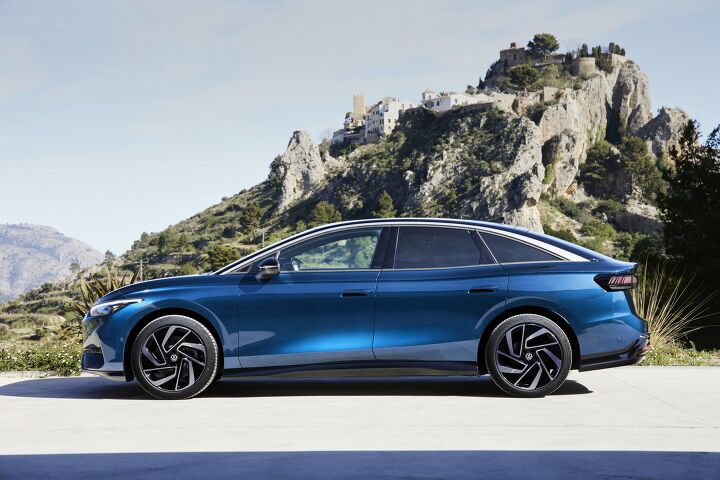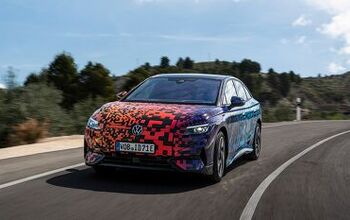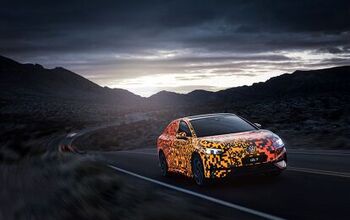Volkswagen ID.7: This is It

We've been covering the Volkswagen ID.7 in the lead-up to today's unveiling, and now we have the official deets.
The ID.7 will launch first in Europe and China this fall before coming to North America in 2024.
EV ranges keep climbing upward, and Volkswagen claims that one version of the ID.7 -- the Pro S with an 86 kWh battery -- will have a range of up to 435 miles. Meanwhile, the ID.7 Pro with a 77 kWh battery will get up to 382 miles of range.
VW is promising some other interesting tech -- a standard augmented reality head-up display, massaging climate-controlled seats, and "smart" air vents that are "interactive."
The ID.7 sedan won't be small -- the car is 195.3 inches long. It's long and low, with a 116.8-inch wheelbase, short overhangs, and the lowest model checking it at 60.6 inches. The drag coefficient can go as low as 0.23.
Power is a claimed 282 horsepower and it comes from a permanent magnet synchronous motor. There's a two-stage, one-speed gearbox to get that power to the ground.
The 77 kWh battery in the Pro will have up to 170 kW in DC fast charging, with the other battery having up to 200 kW. The battery will be preconditioned for charging whenever the driver uses the nav system to guide the car to the nearest charging station.
Interior features include a digital dash and optional ambient lighting. VW says the head-up display is customizable so that the driver can get the info they want while keeping their eyes on the road. The system will project information such as vehicle speed relatively close to the driver, but other info, such as navigation turn arrows, will be spaced further out. Additionally, that info will match up with the real world. Meaning that things like turn arrows should align with the street you need to turn onto.
The infotainment screen is 15 inches and split up -- it's also customizable.
Unfortunately, Volkswagen is continuing to use touch sliders for audio and climate controls. Speaking of audio, a Harmon Kardon system that has four modes meant to adjust for music/sound type is available. The car also has a voice assistant.
Optional seats can automatically adjust their climate control based on temperature and moisture sensors. Oh, and they can massage your back.
Meanwhile, smart vents open and close automatically in order to keep the climate at the desired setting.
Other notable features include a panoramic sunroof with glass that can switch between opaque and transparent, assisted parking, limited assisted driving -- Europe only for now -- and assisted lane changing (it's unclear if that's Europe only or available elsewhere.
Outside, key details include LED lighting and light strips front and rear.
My quick take is that this car has handsome exterior looks, at least based on the photos, but I am saddened that VW has continued to double down on haptic-touch sliders and knob-free interiors.
We'll know more about things like pricing and other specs as we get closer to launch.
[Images: Volkswagen]
Become a TTAC insider. Get the latest news, features, TTAC takes, and everything else that gets to the truth about cars first by subscribing to our newsletter.

Tim Healey grew up around the auto-parts business and has always had a love for cars — his parents joke his first word was “‘Vette”. Despite this, he wanted to pursue a career in sports writing but he ended up falling semi-accidentally into the automotive-journalism industry, first at Consumer Guide Automotive and later at Web2Carz.com. He also worked as an industry analyst at Mintel Group and freelanced for About.com, CarFax, Vehix.com, High Gear Media, Torque News, FutureCar.com, Cars.com, among others, and of course Vertical Scope sites such as AutoGuide.com, Off-Road.com, and HybridCars.com. He’s an urbanite and as such, doesn’t need a daily driver, but if he had one, it would be compact, sporty, and have a manual transmission.
More by Tim Healey
Latest Car Reviews
Read moreLatest Product Reviews
Read moreRecent Comments
- UnoGeeks Great information. Unogeeks is the top SAP ABAP Training Institute, which provides the best SAP ABAP Training
- ToolGuy This thing here is interesting.For example, I can select "Historical" and "EV stock" and "Cars" and "USA" and see how many BEVs and PHEVs were on U.S. roads from 2010 to 2023."EV stock share" is also interesting. Or perhaps you prefer "EV sales share".If you are in the U.S., whatever you do, do not select "World" in the 'Region' dropdown. It might blow your small insular mind. 😉
- ToolGuy This podcast was pretty interesting. I listened to it this morning, and now I am commenting. Listened to the podcast, now commenting on the podcast. See how this works? LOL.
- VoGhost If you want this to succeed, enlarge the battery and make the vehicle in Spartanburg so you buyers get the $7,500 discount.
- Jeff Look at the the 65 and 66 Pontiacs some of the most beautiful and well made Pontiacs. 66 Olds Toronado and 67 Cadillac Eldorado were beautiful as well. Mercury had some really nice looking cars during the 60s as well. The 69 thru 72 Grand Prix were nice along with the first generation of Monte Carlo 70 thru 72. Midsize GM cars were nice as well.The 69s were still good but the cheapening started in 68. Even the 70s GMs were good but fit and finish took a dive especially the interiors with more plastics and more shared interiors.









































Comments
Join the conversation
"ICE engineers took their sweet time giving us reasonable specific output..."
Cars from the 60s were fast, but they polluted a lot; pollution controls added in the 70s killed horsepower. It took 30 years to figure out how to make powerful, clean-burning engines.
Yes thank you!